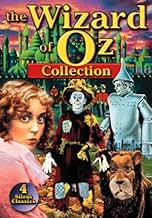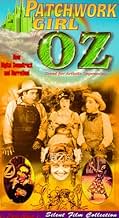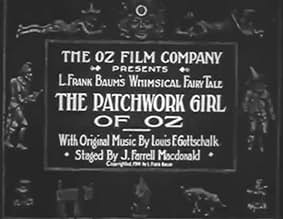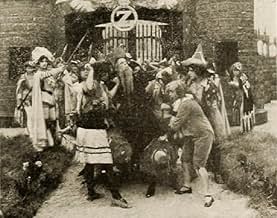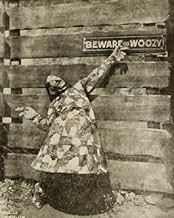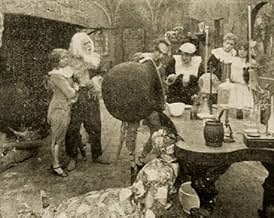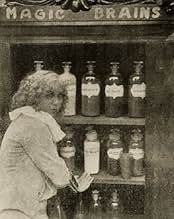Ojo and Unc Nunkie are out of food, so they decide to journey to the Emerald City where they will never starve.Ojo and Unc Nunkie are out of food, so they decide to journey to the Emerald City where they will never starve.Ojo and Unc Nunkie are out of food, so they decide to journey to the Emerald City where they will never starve.
Leontine Dranet
- Margolotte, his wife, who makes the Patchwork Girl
- (as Haras Dranet)
Richard Rosson
- Danx, a Noble Munchkin
- (as Dick Rosson)
Bert Glennon
- The Scarecrow
- (as Herbert Glennon)
Hal Roach
- The Cowardly Lion
- (as Al Roach)
- …
Dave Anderson
- The Hungry Tiger
- (as Andy Anderson)
Pierre Couderc
- Scraps, the Patchwork Girl
- (as The Marvelous Couderc)
Featured reviews
As a child, The Patchwork Girl of Oz was my favorite Oz book. This silent film version is a charming look at how Oz was envisioned by it's creator--L. Frank Baum produced the film. The story however does stray from the book and some of the scenes are a bit disjointed. Motion pictures were in their infancy in 1914--most films were stagebound dramas, so to see a fantasy film from this period is unique.
The Patchwork Girl or "Scraps" is played by French acrobat Pierre Couderc. The part where Scraps catches the eye of the Scarecrow is very amusing. Also, the Yoop character is a forerunner to the Winged Monkeys who terrorized Judy Garland 25 years later.
In the video version I saw, the pivotal scene where Scraps is brought to life and tips over the Liquid of Petrification, is missing or destroyed--but the rest of the film is intact however.
The Patchwork Girl or "Scraps" is played by French acrobat Pierre Couderc. The part where Scraps catches the eye of the Scarecrow is very amusing. Also, the Yoop character is a forerunner to the Winged Monkeys who terrorized Judy Garland 25 years later.
In the video version I saw, the pivotal scene where Scraps is brought to life and tips over the Liquid of Petrification, is missing or destroyed--but the rest of the film is intact however.
"The Patchwork Girl of Oz" was the most racist of L. Frank Baum's Oz novels, featuring the Tottenhots (stereotyped Africans) and also an ambulatory Victrola phonograph that sings ragtime songs in an offensive "darky" dialect. Fortunately, this film version (written and directed by Baum himself) omits the ragtime racism and reconceives the Tottenhots so that they're only barely recognisable as racist stereotypes. This is a fun movie, which I recommend without reservation for adults and kids.
It is of course rather a crude film, even by silent standards, and hampered by cross-sexed casting in both directions. The hero of the film, a Munchkin boy named Ojo, is obviously played by an adult woman. The Patchwork Girl, Scraps, is very obviously played by a man. However, Pierre Couderc, the French acrobat who plays this role, gives an incredible performance. He effortlessly turns backward handsprings and shoulder kips, his performance made even more amazing by the bulky costume and elaborate hoop skirt he's wearing. There's one very amusing sight gag when the Patchwork Girl and the Scarecrow meet for the first time. Ah, true love!
The plot of this film is a simplified version of the Oz novel. Orphan boy Ojo and his elderly Unk Nunkie visit Doctor Pipt the magician. Pipt has invented the Powder of Life, which brings life to any inanimate object it touches. (Why doesn't it animate its own container?) Pipt's wife Margolotte has made a girl dummy out of patchwork quilts, which will become Margolotte's maidservant after Pipt animates it. When Pipt brings the Patchwork Girl to life, her exuberance causes her accidentally to spill another elixir over Margolotte and Unk Nunkie, which transforms them into marble statues. Dr Pipt can't reverse the enchantment until he mixes another batch of the Powder of Life, which requires certain ingredients ... including three hairs from a Woozy's tail. Ojo sets forth to obtain the ingredients.
Animal impersonator Fred Woodward does amazing work as several different animals. Woodward is the spiritual father of Janos Prohaska, a 1960s stuntman who specialised in portraying animals and aliens. One of the roles Woodward plays here is the Woozy, a creature whose body is made of cardboard boxes. (This is a very low-budget movie, but that's part of its charm.) The squared-off look of the Woozy in the Oz book's illustrations was obviously inspired by the low-budget costume worn by Woodward in this movie.
TRIVIA NOTE: Watch for Harold Lloyd and Hal Roach Snr (very early in their careers) in grass skirts and body paint as two of the Tottenhots. Shortly after this movie was filmed, Roach received the inheritance which enabled him to set up his own film studio. Juanita Hansen, later a Roach actress, appears briefly here. Also glimpsed is Charles Ruggles, who would soon get his big break as Private Files in L. Frank Baum's stage musical "Tik-Tok in Oz".
"The Patchwork Girl of Oz" is an absolute delight, which adults and children will enjoy in repeated viewings. There are some impressive sets and costumes, despite the low budget. Jaded modern audiences will sneer at the very crude special effects, but I would rather watch this movie instead of a certain overrated MGM musical starring Liza Whatsername's mother.
It is of course rather a crude film, even by silent standards, and hampered by cross-sexed casting in both directions. The hero of the film, a Munchkin boy named Ojo, is obviously played by an adult woman. The Patchwork Girl, Scraps, is very obviously played by a man. However, Pierre Couderc, the French acrobat who plays this role, gives an incredible performance. He effortlessly turns backward handsprings and shoulder kips, his performance made even more amazing by the bulky costume and elaborate hoop skirt he's wearing. There's one very amusing sight gag when the Patchwork Girl and the Scarecrow meet for the first time. Ah, true love!
The plot of this film is a simplified version of the Oz novel. Orphan boy Ojo and his elderly Unk Nunkie visit Doctor Pipt the magician. Pipt has invented the Powder of Life, which brings life to any inanimate object it touches. (Why doesn't it animate its own container?) Pipt's wife Margolotte has made a girl dummy out of patchwork quilts, which will become Margolotte's maidservant after Pipt animates it. When Pipt brings the Patchwork Girl to life, her exuberance causes her accidentally to spill another elixir over Margolotte and Unk Nunkie, which transforms them into marble statues. Dr Pipt can't reverse the enchantment until he mixes another batch of the Powder of Life, which requires certain ingredients ... including three hairs from a Woozy's tail. Ojo sets forth to obtain the ingredients.
Animal impersonator Fred Woodward does amazing work as several different animals. Woodward is the spiritual father of Janos Prohaska, a 1960s stuntman who specialised in portraying animals and aliens. One of the roles Woodward plays here is the Woozy, a creature whose body is made of cardboard boxes. (This is a very low-budget movie, but that's part of its charm.) The squared-off look of the Woozy in the Oz book's illustrations was obviously inspired by the low-budget costume worn by Woodward in this movie.
TRIVIA NOTE: Watch for Harold Lloyd and Hal Roach Snr (very early in their careers) in grass skirts and body paint as two of the Tottenhots. Shortly after this movie was filmed, Roach received the inheritance which enabled him to set up his own film studio. Juanita Hansen, later a Roach actress, appears briefly here. Also glimpsed is Charles Ruggles, who would soon get his big break as Private Files in L. Frank Baum's stage musical "Tik-Tok in Oz".
"The Patchwork Girl of Oz" is an absolute delight, which adults and children will enjoy in repeated viewings. There are some impressive sets and costumes, despite the low budget. Jaded modern audiences will sneer at the very crude special effects, but I would rather watch this movie instead of a certain overrated MGM musical starring Liza Whatsername's mother.
You really have to look at "The Patchwork Girl of Oz" in context, otherwise you'll just dismiss it as a dull and incomprehensible movie. But, back in 1914, it was a rather impressive tale--but one that even audiences back then probably struggled to understand unless they'd read the Frank Baum story. Heck, I tried watching it was was TOTALLY confused until I read a summary of the story on the internet! That's because the narrative is really scant--with almost no intertitle cards. Instead, it's shown as a series of tenuously connected vignettes which are described on the card and then acted out...as was the style up until about 1914 or a bit later. It comes off almost like a slide show that is acted out for the audience! This certainly is NOT all that entertaining and too often the characters just cavort about aimlessly or do acrobatics instead of acting--and it comes off pretty poorly. BUT, again, it was pretty much the style of the day. The ladies in the film and sets and 'magic' were pretty similar to the work done a decade earlier by the groundbreaking French film maker Georges Méliès. By 1914, these amazing effects and story telling really were a a bit passé--definitely on their way out--which might explain why the film was a critical flop--that, and the fact that the audience probably had no idea what was occurring on screen! Interesting from a historical perspective and having excellent production values for the time, but still very easy to skip unless you adore very early silent films.
The recent phenomenon of Harry Potter isn't so unusual. An early case it the amazing popularity of Oz.
The books, the first ones, became popular, amazingly so. By some measures more popular than Potter. They are simple: children, a magical land rather a land like ours in many ways but with magic and magical creatures.
Then the movies started. Magic sells cinematically when the world is like the one we live in plus magic that matches what the camera can emulate. When the writer understands the overlap, he or she can write books that are cinematically rooted. Each feeds the other. Each feeds the juvenile imagination.
You should watch this. Because with distance, you can see how shallow that imagination is. The effects of today's movies are better, but they are no less believable to us than these were in their day. Let that soak in and you'll get pretty depressed about the current Potter phenomenon (and probably increase your appreciation for the "Rings" works).
Ted's Evaluation -- 2 of 3: Has some interesting elements.
The books, the first ones, became popular, amazingly so. By some measures more popular than Potter. They are simple: children, a magical land rather a land like ours in many ways but with magic and magical creatures.
Then the movies started. Magic sells cinematically when the world is like the one we live in plus magic that matches what the camera can emulate. When the writer understands the overlap, he or she can write books that are cinematically rooted. Each feeds the other. Each feeds the juvenile imagination.
You should watch this. Because with distance, you can see how shallow that imagination is. The effects of today's movies are better, but they are no less believable to us than these were in their day. Let that soak in and you'll get pretty depressed about the current Potter phenomenon (and probably increase your appreciation for the "Rings" works).
Ted's Evaluation -- 2 of 3: Has some interesting elements.
The most famous movie adaptation of a novel by L. Frank Baum entails Toto, a tornado, ruby slippers and a yellow brick road. Well, it turns out that Victor Fleming's 1939 adaptation was not the first. An earlier screen version of "The Wizard of Oz" was a 1925 loose adaptation of the story, notable for casting Oliver Hardy as the Tin Woodsman.
And then there were the adaptations in which Baum himself participated. He founded the Oz Film Manufacturing Company and made some movie versions of his novels. These aren't the most sophisticated adaptations but are worth seeing as a look into early cinema. "The Patchwork Girl of Oz" features things like people getting turned into statues (and one of them getting shrunken down so that a woman can carry him). Yeah, Baum came up with some wacky stuff.
One interesting thing about this movie is that the lion is played by none other than Hal Roach, best known as the producer of Laurel & Hardy's movies. It appears that only Stan Laurel didn't get to go to Oz on the silver screen. Of course, I can't picture him in Oz without imagining that he would have turned everything upside down. In other words, it would have been another fine mess that he'd gotten himself into!
Anyway, this movie is worth seeing. I wonder what Baum would have thought of the most famous adaptation of his work, had he lived to see it.
And then there were the adaptations in which Baum himself participated. He founded the Oz Film Manufacturing Company and made some movie versions of his novels. These aren't the most sophisticated adaptations but are worth seeing as a look into early cinema. "The Patchwork Girl of Oz" features things like people getting turned into statues (and one of them getting shrunken down so that a woman can carry him). Yeah, Baum came up with some wacky stuff.
One interesting thing about this movie is that the lion is played by none other than Hal Roach, best known as the producer of Laurel & Hardy's movies. It appears that only Stan Laurel didn't get to go to Oz on the silver screen. Of course, I can't picture him in Oz without imagining that he would have turned everything upside down. In other words, it would have been another fine mess that he'd gotten himself into!
Anyway, this movie is worth seeing. I wonder what Baum would have thought of the most famous adaptation of his work, had he lived to see it.
Did you know
- TriviaHarold Lloyd and Hal Roach, who both have minor roles in this film, met on this set in San Diego. Roach was impressed by Lloyd's energy and sought him out when he formed his production company The Rolin Film Company in July 1914 after receiving a small inheritance. Although their association was stormy, their association was ultimately one of the most successful in silent film history.
- GoofsThe character of Ojo is stated several times to be a boy, but is referred to as a girl in one of the dialogue caption cards.
- ConnectionsFeatured in American Masters: Harold Lloyd: The Third Genius (1989)
- How long is The Patchwork Girl of Oz?Powered by Alexa
Details
- Runtime
- 1h 21m(81 min)
- Color
- Sound mix
- Aspect ratio
- 1.33 : 1
Contribute to this page
Suggest an edit or add missing content

